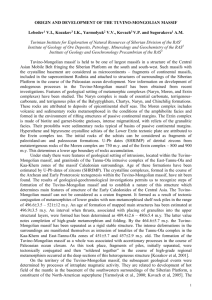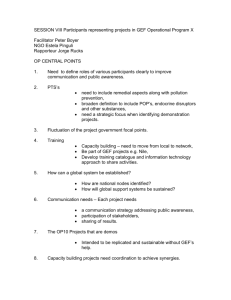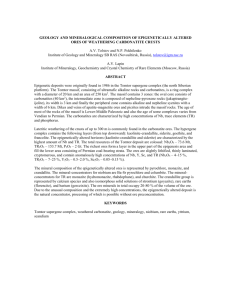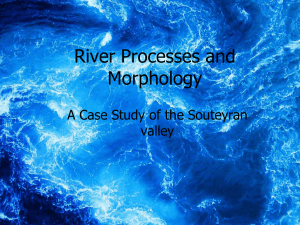Biodiversity Conservation in the
advertisement
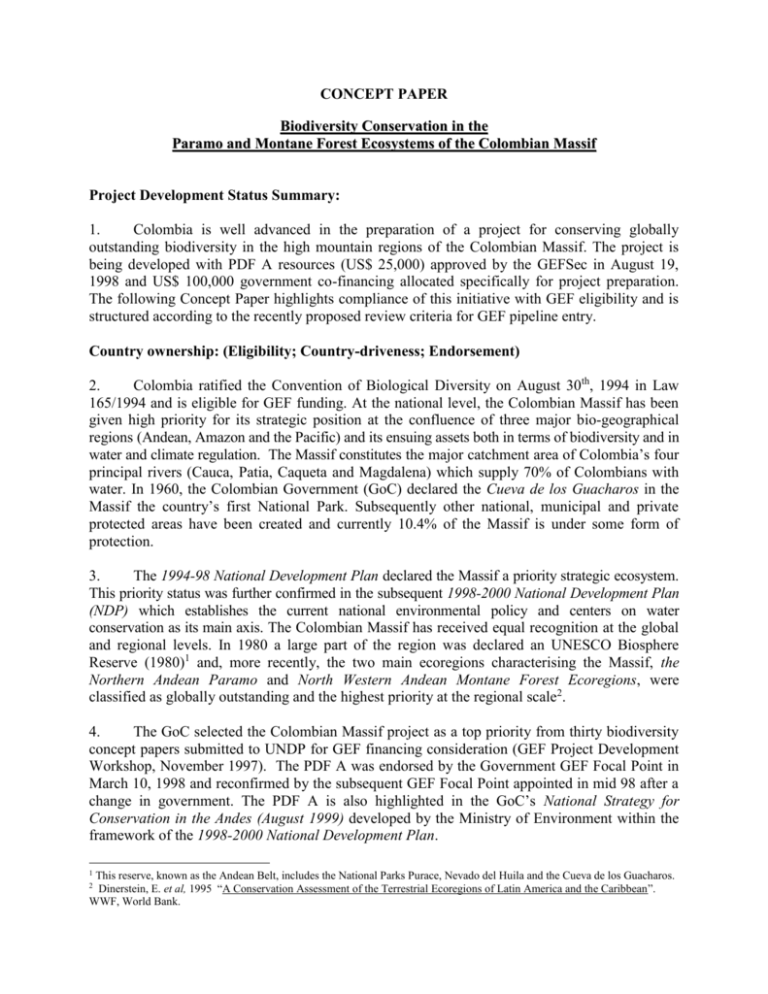
CONCEPT PAPER Biodiversity Conservation in the Paramo and Montane Forest Ecosystems of the Colombian Massif Project Development Status Summary: 1. Colombia is well advanced in the preparation of a project for conserving globally outstanding biodiversity in the high mountain regions of the Colombian Massif. The project is being developed with PDF A resources (US$ 25,000) approved by the GEFSec in August 19, 1998 and US$ 100,000 government co-financing allocated specifically for project preparation. The following Concept Paper highlights compliance of this initiative with GEF eligibility and is structured according to the recently proposed review criteria for GEF pipeline entry. Country ownership: (Eligibility; Country-driveness; Endorsement) 2. Colombia ratified the Convention of Biological Diversity on August 30th, 1994 in Law 165/1994 and is eligible for GEF funding. At the national level, the Colombian Massif has been given high priority for its strategic position at the confluence of three major bio-geographical regions (Andean, Amazon and the Pacific) and its ensuing assets both in terms of biodiversity and in water and climate regulation. The Massif constitutes the major catchment area of Colombia’s four principal rivers (Cauca, Patia, Caqueta and Magdalena) which supply 70% of Colombians with water. In 1960, the Colombian Government (GoC) declared the Cueva de los Guacharos in the Massif the country’s first National Park. Subsequently other national, municipal and private protected areas have been created and currently 10.4% of the Massif is under some form of protection. 3. The 1994-98 National Development Plan declared the Massif a priority strategic ecosystem. This priority status was further confirmed in the subsequent 1998-2000 National Development Plan (NDP) which establishes the current national environmental policy and centers on water conservation as its main axis. The Colombian Massif has received equal recognition at the global and regional levels. In 1980 a large part of the region was declared an UNESCO Biosphere Reserve (1980)1 and, more recently, the two main ecoregions characterising the Massif, the Northern Andean Paramo and North Western Andean Montane Forest Ecoregions, were classified as globally outstanding and the highest priority at the regional scale2. 4. The GoC selected the Colombian Massif project as a top priority from thirty biodiversity concept papers submitted to UNDP for GEF financing consideration (GEF Project Development Workshop, November 1997). The PDF A was endorsed by the Government GEF Focal Point in March 10, 1998 and reconfirmed by the subsequent GEF Focal Point appointed in mid 98 after a change in government. The PDF A is also highlighted in the GoC’s National Strategy for Conservation in the Andes (August 1999) developed by the Ministry of Environment within the framework of the 1998-2000 National Development Plan. 1 This reserve, known as the Andean Belt, includes the National Parks Purace, Nevado del Huila and the Cueva de los Guacharos. Dinerstein, E. et al, 1995 “A Conservation Assessment of the Terrestrial Ecoregions of Latin America and the Caribbean”. WWF, World Bank. 2 Programme & Policy Conformity 5. The proposed project will protect two globally outstanding ecosystems currently under threat. The Northern Andean Paramo - found between 3,000 and 4,000 m.a.s.l - is a highly vulnerable system characterised by local endemisms well adapted to the harsh climate and high elevations. The Northwest Andean Montane forest - occurs between 2,000 and 3,000 m.a.s.l - and is characterised by high beta diversity and regional and local endemisms. As such, this proposal falls within OP #4 Mountain Ecosystems, but will have clear links to the OP# 3 Forests. In view of the fragility and severe land degradation of mountain areas, it will also address the crosscutting issue of land degradation. 6. The project will establish a regional network of protected areas, improve buffer zone management by enhancing sustainable land use in areas adjacent to parks, and integrate biodiversity management principles into regional and local processes. It has been developed through extensive local consultation and will be implemented with a high degree of participation from a wide group of stakeholders (as detailed in paragraph 10 below). Additionally it will directly address several issues raised in the CBD particularly those related to: Article 8 (a), (b) (d), (i); Article 7 (a) ; Article 10 (d). Project Design 7. Problem Statement: The Colombian Massif supports an exceptional diversity of habitats and species3 increasingly under threat. Despite the early and substantial action taken by the GoC to ensure that 10% of the Massif falls under some protected area category, the different management systems existing between the national parks, municipal, and private areas have inadvertently weakened co-ordinated conservation practices in the region. Overlapping jurisdiction in buffer zones4, absence of clear management plans, coupled with staff and equipment shortages have further undermined the protected areas’ contribution towards conserving biodiversity. Resource depletion from hunting and firewood collection is increasing and many protected areas have growing numbers of colonists settling within their boundaries. Habitat loss is also increasing in unprotected land as native forest is felled for cattle rearing or brought under cultivation. Agricultural practices are unsustainable and inappropriate for the fragile mountain soils, causing increasing land degradation, soil erosion, further biodiversity loss and productivity failures. This has accentuated poverty conditions in the region with food security problems causing increasing encroachment on remaining tracts of natural vegetation for food and wood for energy. 8. Baseline Scenario: The GoC - through its Alternative Development Plan (PLANTE) - has taken action to alleviate poverty and determine a more sustainable development for the region. Investments under PLANTE have, and will continue to focus on, education, health, rural electrification, road and housing projects, land acquisition schemes and productive projects. 3 Over 10% of Colombian flora, 52 species of amphibians, 62 reptiles and 56 birds are found in the region and in the higher areas between 2,000 to 3,100m endemic species, including the red breasted parrot Bolborhynchus ferrugineifrons, are common, as well as many species with restricted distribution. 4 This is exacerbated by the fact that, while National Natural Parks fall under the direct mandate of the Ministry of the Environment, areas around them fall under the jurisdiction of Regional Environmental Authorities, five of which have jurisdiction in the Massif. Substitution of illicit crops (cultivation of illicit crops, particularly poppies is beginning on mountain slopes between 2,000 and 3,000 m) is also being planned under this programme but there is a lack of known alternatives for the harsh mountain conditions present in this area. Furthermore, caution needs to be observed so that substitution with traditional agricultural crops does not lead to still further biodiversity losses. 9. An Action Plan for the Environmental Land-zoning of the Colombian Massif is presently being developed within an agreement signed between the five regional environmental agencies that have jurisdiction in the area and IDEAM. However, this does not fully address deficiencies in the protected areas system nor does it adequately incorporate biodiversity management principles in the region’s sectoral development planning. Under this scenario, protected areas will continue to play a sub-optimal role in conserving the rich biological and cultural heritage of this region, encroachment will increase and habitat loss due to inappropriate land-use will continue to expand. Irreversible loss will be incurred to globally outstanding biodiversity. 10. GEF Alternative: Under the proposed alternative a sub-regional network of national, regional, municipal, private and indigenous protected areas will be established, with clearly defined and compatible management categories and strategies, to conserve the paramo and montane ecosystems of the Colombian Massif. Whilst focusing on the Massif as a regional planning unit, the proposed project will center on areas between 2,000 and 4,000 m.a.s.l. and particularly on the Biosphere Andean Belt Reserve and its extention. This will provide the required linkages to the South with the National Natural Park Nevado del Huila and to the North with the National Natural Park Galeras (the Andean Belt Reserve includes the National Parks Purace, Nevado del Huila, Las Hermosas and the Cueva de los Guacharos). The project will strengthen existing protected areas within this sub-region and set up new ones in strategic locations to form corridors that enhance gene flow and thus long-term viability of remaining habitat blocks. Participatory management plans will be developed for existing and potential areas and the capacities of local stakeholders strengthened for their implementation. Actions at this level will also include improvement of basic protected area infrastructure, demarcation, enhancing control and regulatory frameworks and strengthening information systems with the necessary data for ecosystems monitoring and the planning of effective conservation mechanisms. 11. The project will also work closely with local and indigenous communities in buffer zones to develop alternative forms of livelihood and agricultural practices more apt for the fragile soils of the mountain areas thus reducing encroachment of protected areas. A biodiversity overlay will be developed for the regional land-zoning plan currently under formulation by the GoC to ensure long-term compatibly with the sub-regional network of protected areas in Paramo and Montane ecosystems. This overlay will be complemented with a capacity-building programme aimed at regional and local governments and private institutions to incorporate biodiversity management principles in the sectoral development processes of the region. Global Benefits and Incrementality: 12. By implementing measures to conserve outstanding, endangered biodiversity the proposed project will provide direct global benefits. Over half of the world’s Northern Andean Paramo is found in Colombia and 22.2% of this is in the Massif with thirteen separate Paramo areas, covering a total of 256,658 hectares. The second major ecoregion, the NorthWest Andean montane forest, occurs between 2,000 and 3,000 m.a.s.l in the Massif and covers an area of 1,371,613 hectares. Whilst the percentage of this ecoregion is lower (5% of the national total) it is considered to be the most threatened ecosystem in Colombia, and is characterized by high beta diversity and regional and local endemisms. 13. These ecoregions with a variety of life-zones5 across the wide altitudinal range of the Massif (2.000-4.380 m.a.s.l) support an exceptional diversity of habitats and species. Over 10% of Colombian flora are found in the Massif and a transect between 530 and 4,380 m.a.s.l on the eastern slopes of the region has been estimated at supporting 1,200 higher plant and fern species from 164 families and 414 genera. In terms of fauna 52 species of amphibians, 62 reptiles and 56 birds have been registered and in the higher areas between 2,000 to 3,100m endemic species, including the red breasted parrot Bolborhynchus ferrugineifrons, are common, as well as many species with restricted distribution. In addition to this, the Massif is well known for its cultural heritage with seven indigenous groups in the region - the Paeces, Yanaconas, Guambianos, Coconucos, Totoroes, Inga and Kamentza. 14. Project activities will be entirely complementary to baseline programming which already seek to promote the sustainable development of the Colombian Massif. The project’s complementary activities have been designed to ensure that Protected Areas offer comprehensive protection to globally significant biodiversity and are adequately linked to avoid more fragmentation of endangered habitats. Baseline activities to substitute illicit crops will be complemented by developing culturally acceptable and ecologically appropriate land-uses that can be adopted under the PLANTE programme and replicated through the region. Whilst concentrating specifically on actions required to raise protection to a level that provides global benefits, the project will indirectly produce some long-term domestic benefits by favorably affecting the quality and quantity of the river flow emanating from this region. Stakeholder Involvement 15. At the national level, the Ministry of the Environment has led project development, through its National Parks Service (UAESPNN) charged with the co-ordination and establishment of the national system of protected areas-SINAP.6 Within the UAESPNN the Southern Andean Regional Unit is responsible for consultations at the regional and local levels during project development and will be largely responsible for implementation in co-ordination with key regional stakeholders. The five Regional Environment Authorities7 with jurisdiction in the Massif are major stakeholders as well as the municipal level representatives from local government planning departments and environmental units charged with the administration of municipal protected areas. A wide range of civil society will also form part of the project including members from the seven indigenous groups in the Massif, (the Paeces, Yanaconas, Guambianos, Coconucos, Totoroes, Inga and Kamentza), park and buffer zone inhabitants, 5 A finer classification identifies eight different systems in the Massif: Above the snow line (4.342 hectares); Paramo (256.658 Hectares); High Andean Forest (1’351.126 Hectares). Low Andean Forest 20.483 Hectares; Andean agroecosystems (1,525.123 hectares); Inter-Andean agro-ecosystems 17.190 hectares; Semi- arid, xerofitic scrub 92,432 hectares and human settlements 856 hectares. 6 Decree 1124 of 1999: Article 24 items 1and 2; Article 27 item 1; Article 28 item s 1 and 4 High Magdalena Regional Corporation -CAM- covering the department of Huila; CRC- covering the department of Cauca; CORTOLIMA covering the department of Tolima; CORPONARINO -covering the department of Narino; and to a smaller extent the Corporation for the Development of the South of Amazonia CORPOAMAZONIA-covering Caqueta, Amazonas, Putumayo; 7 environmentally–related non-governmental organisations and private sectors representatives. Technical backstopping to this locally driven project will be provided through the nationally based institutes Von Humboldt (charged with developing national biodiversity strategies) and IDEAM. All these stakeholders are being consulted during project preparation and will take active parts in implementation. Financing: 16. Contributors to the full-scale project will include the World Food Programme to develop sustainable agricultural practices in the buffer zones of the Las Hermosas, Nevado de Huila, Purace and Cueva de los Guachos National Parks through the “Eco-andean Sustainable Development” programme; the UNCDP and national funds including the Plan Verde and the Fondo de Regalias which allocates specific resources to the Massif in recognition of its strategic importance. Total project costs are expected to be in the range of US$ 8 million of which GEF would contribute an estimated US$ 5 million with 3 million leveraged as co-financing. Baseline financing will primarily come from the GoC, including relevant allotments from the five Regional Environmental Authorities mentioned above. Institutional and IA Coordination and links with other GEF projects: 17. The proposed project is part of a well-structured and co-ordinated National Strategy for the Conservation of the Andes that includes four complementary projects under preparation for GEF financing consideration. These projects include an umbrella project which focuses on issues best addressed from a national level perspective, and three sub-regional site specific projects focusing on different globally outstanding ecosystems. 18. The three sub-regional projects are: Protection of the Colombian Massif (UNDP) located in a strategic location at the division of the Andean Cordillera into three different ranges largely responsible for the country’s mega-diversity; and two unique Andean outcrops the Sierra Nevada de Santa Marta (WB), recently approved at the Dec 99 council) and La Serrania de Macarena currently under formulation through UNDP/GEF PDF B resources. The umbrella project Biodiversity Conservation in the Andes is being developed by the WB with PDF B preparatory funds. 19. In compliance with GEF procedures, the request for PDF A resources to develop this current proposal for conservation in the Colombian Massif, was circulated to the GEF Secretariat and IA agencies prior to its approval by UNDP in August 98. The PDF A was found “eligible, well prepared and containing substantive and useful information” with the GEFSec endorsing its approval (please refer to GEFSec fax dated 19 August 98 to Rafael Asenjo from Mario Ramos reg: PDF A: Colombia: Biodiversity conservation in the Paramo and Montane Forests Ecosystems of the Colombian Massif). 20. In addition to this, extensive consultations between project teams and IAs within country and in HQ have been undertaken to ensure geographic and thematic complementarity between these initiatives. Indeed the Block B PDF for the umbrella project was approved in October 1998 under the understanding that this would not intervene in the Massif areas targeted by the PDFA already under execution at that time. 21. The WB Andean umbrella project, in addition to developing national based components such as stakeholder networks, targeted research, institutional strengthening and developing conservation incentives and user-payer schemes for environmental services, will also include a component that focuses on establishing regional conservation systems. As such, joint working sessions were held in January, March, July and October of 1999 with IAs and project teams to ensure that there was no overlap would occur between these regional systems and the three subregional projects/site-specific projects mentioned above. Equal attention was paid to including target ecosystems with distinct global biodiversity value. 22. As a result, the WB project will concentrate on five macro regions as follows: The high plains of Cundinamarca and Boyaca; the northeastern region of oak forest and paramos of Cucuy and la Rusia that have distinct biodiversity than Massif paramos; the national natural park of the Nevados and the Florencia forest; the Patia valley and the biological corridor of the national natural park Farallones-Munchique and the upper Putumayo and Caqueta zones focusing on the transition between tropical rainforest to the Montane forest of the Andean region. 23. These consultations and joint efforts have ensured the maximum of synergy between the UNDP and WB GEF financed initiatives. The three sub-regional projects have been developed locally with sites for new protected areas negotiated with local communities during project preparation. Equally, the WB umbrella project, by including components related to macro policy frameworks, will provide useful information for the three projects focusing on specific subregions. 24. Finally, this programme approach for the Andes has been considered the more viable and cost effective by the GoC, UNDP and the WB for the following reasons: i) the three sub-regional/ site-specific projects rest heavily on community participation in conservation; ii) have been prepared through long locally-driven processes; and iii) will be implemented in three very distinct areas of the country, each with widely different ethnic groups and socio-economic conditions. The Sierra Nevada has long been recognized as having unique cultural dynamics centering on the Cogi indians; The Massif is still more culturally diverse with seven well-defined and strong ethnic groups (see paragraph 10) and the Macarena, whilst less diverse in ethnic terms, requires a specific approach to determine valid and sustainable conservation action with high local input and linkages with the peace talks that are advancing in this region. Such participation would not be cost-effective in one centrally based project functioning through institutions that do not have the local representation required for these locally driven processes.
